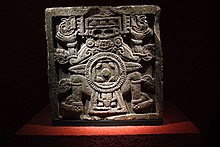Tlaltecuhtli
Tlaltecuhtli ( Nahuatl : Lord / Mistress of the Earth, also Tlaltecutli ) was a Central American god figure, which was of importance in Aztec mythology as well as in the belief systems of other Nahuatl-speaking peoples of Central America.
Appearance and assignments
Tlaltecuhtli is described as both a female and a male being. It possessed attributes of both a toad and an alligator. Representations of the deity were found mainly in the post-classical period of Central American history . Tlaltecuhtli is also known from post-Columbian manuscripts. Sometimes the deity is associated with Cihuacoatl , Tonantzin and Tonatiuh . In the Tonalamatl of the Codex Borbonicus , Tlaltecuhtli is assumed to be the second hour of the day. There are also significant parallels to the Mayan creation mythology , as reproduced in the Relación de las cosas de Yucatán by Diego de Landas .
Aztec creation myth
In Aztec mythology there were various creation myths that were passed on parallel to one another. One of these is described in the Histoyre du Mechique . According to her, Quetzalcoatl and Tezcatlipoca came down from heaven at the beginning of the world to examine Tlaltecuhtli. However, since Tlaltecuhtli was such a hideous monster and so voracious that she had throats not only on her face, but also on her knees and elbows, the two gods thought that such a monster in the ocean would not be a successful creation. In order to get the monster out of the way, they both turned into giant snakes. Then they tore Tlaltecuhtli in two, so that one half formed the earth and the other the sky. To compensate Tlaltecuhtli for her mutilation, the gods decreed that her body should serve as a basis for all human food plants. And so that the earth can continue to grow food for people, it sometimes calls at night and demands human sacrifices.
New finds
In 2006, next to the ruins of the sacred Aztec pyramid Templo Mayor, a twelve-ton, rectangular monolith made of pale pink andesite was discovered in a two and a half meter deep shaft on Zócalo Square in the center of Mexico City, on which Tlaltecuhtli was also depicted. On this relief stone Tlaltecuhtli is an earth goddess and is depicted crouching, giving birth to a child and at the same time drinking the blood of her afterbirth. The mouth of the monstrous Aztec earth goddess is wide open to take in the dead. The find thus clearly symbolizes the principle of Aztec mythology: The idea of a dualism of complementary opposites as the origin of creation.
Based on this find and others (especially offerings), the team of archaeologists, led by Leonardo López Luján , hopes to find the grave of the Aztec ruler Ahuitzoti. The statue itself gives the clue: When the earth goddess Tlaltecuhtli was discovered, López Luján noticed that the figure of the god was holding a rabbit in its right claw foot. Ten points could be seen above it. In the Aztec script, “10 rabbits” stands for the year 1502. The codices handed down from that period show that Ahuitzotl (pronounced “Ah-ui-tzohtl”), the most feared ruler of the empire, was solemnly buried in that year.
literature
- Karl Andreas Taube : Aztec and Maya myths . Phillip Reclam jun., Stuttgart 1994, ISBN 3-15-010427-0
- George C. Vaillant: The Aztecs . M. Dumont Schaumberg, Cologne 1957
Web links
Individual evidence
- ↑ George C. Vaillant: The Aztecs, pages 184
- ^ Karl Taube: Aztekische und Maya-Mythen , pages 118-121
- ^ Karl Taube: Aztec and Maya myths , pages 62-63
- ↑ Draper, Robert (2010): The Legacy of the Aztecs. In: Nationalgeographic Germany. Issue 11, pp. 38–61
- ↑ Riener, Ulrike (2004): Review of: Taube, Karl: Aztekische und Maya-Mythen. In: Tepe, Peter; Bachmann, Thorsten; Nieden, Birgit zur (Hg): Myth No. 1. Myths in Art, pp. 324-325, here p. 325
- ↑ Draper, Robert (2010): The Legacy of the Aztecs. In: Nationalgeographic Germany. Issue 11, pp. 38–61
